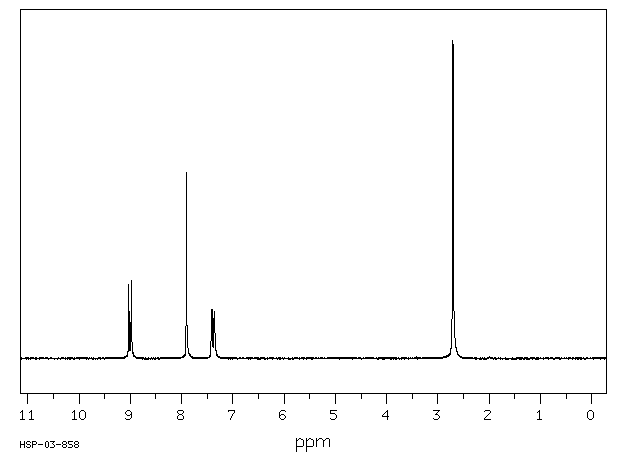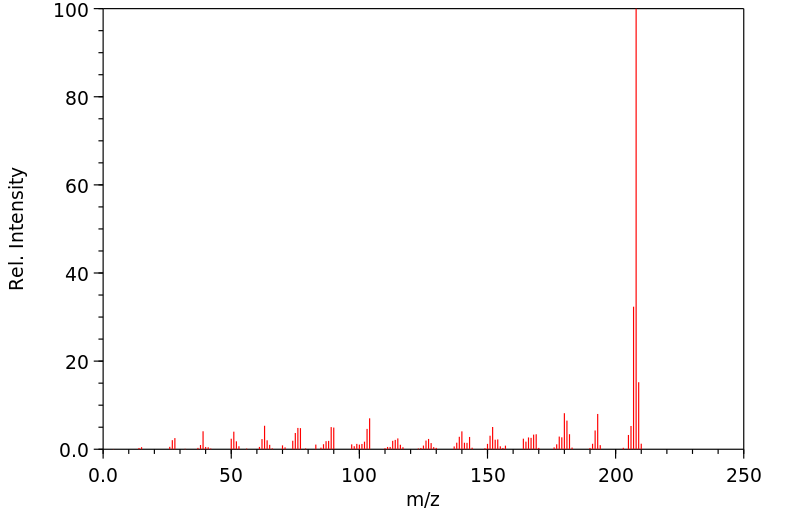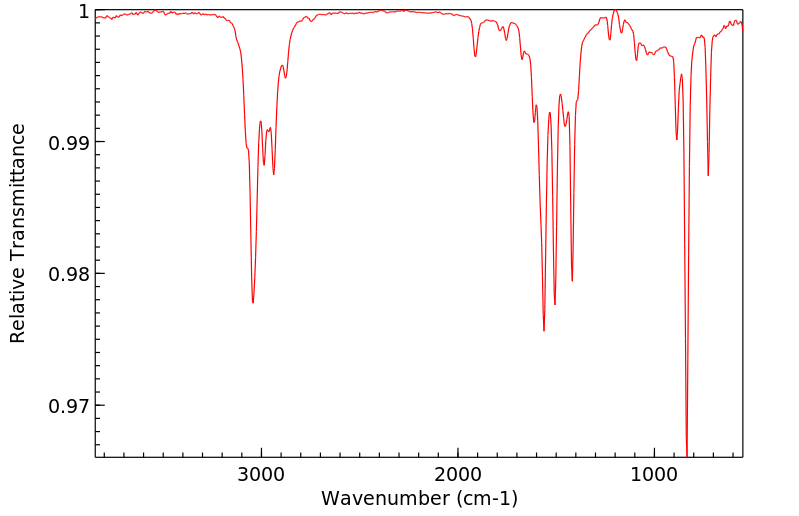4,7-二甲基-1,10-菲咯啉 | 3248-05-3
中文名称
4,7-二甲基-1,10-菲咯啉
中文别名
4,7-二甲基-1,10-菲罗啉;4,7-二甲基-1,10-邻二氮杂菲;4,7-二甲基-1,1-菲咯啉
英文名称
4,7-Dimethyl-1,10-phenanthroline
英文别名
dmphen
CAS
3248-05-3
化学式
C14H12N2
mdl
MFCD00004979
分子量
208.263
InChiKey
JIVLDFFWTQYGSR-UHFFFAOYSA-N
BEILSTEIN
——
EINECS
——
-
物化性质
-
计算性质
-
ADMET
-
安全信息
-
SDS
-
制备方法与用途
-
上下游信息
-
文献信息
-
表征谱图
-
同类化合物
-
相关功能分类
-
相关结构分类
物化性质
-
熔点:193-195 °C(lit.)
-
沸点:338.63°C (rough estimate)
-
密度:1.1202 (rough estimate)
-
溶解度:22.4 mg/L (at 25 °C)
-
稳定性/保质期:
在常温常压下保持稳定
计算性质
-
辛醇/水分配系数(LogP):3.2
-
重原子数:16
-
可旋转键数:0
-
环数:3.0
-
sp3杂化的碳原子比例:0.142
-
拓扑面积:25.8
-
氢给体数:0
-
氢受体数:2
安全信息
-
TSCA:Yes
-
危险品标志:Xn
-
安全说明:S26,S36/37/39
-
危险类别码:R36/37/38
-
WGK Germany:3
-
海关编码:2933990090
-
危险性防范说明:P261,P305+P351+P338
-
危险性描述:H302,H315,H319,H335
-
储存条件:常温、避光、存放在通风干燥处。
SDS
4,7-二甲基-1,10-邻二氮杂菲 修改号码:5
模块 1. 化学品
产品名称: 4,7-Dimethyl-1,10-phenaNThroline
修改号码: 5
模块 2. 危险性概述
GHS分类
物理性危害 未分类
健康危害 未分类
环境危害 未分类
GHS标签元素
图标或危害标志 无
信号词 无信号词
危险描述 无
防范说明 无
模块 3. 成分/组成信息
单一物质/混和物 单一物质
化学名(中文名): 4,7-二甲基-1,10-邻二氮杂菲
百分比: >98.0%(T)
CAS编码: 3248-05-3
分子式: C14H12N2
模块 4. 急救措施
吸入: 将受害者移到新鲜空气处,保持呼吸通畅,休息。若感不适请求医/就诊。
皮肤接触: 立即去除/脱掉所有被污染的衣物。用水清洗皮肤/淋浴。
若皮肤刺激或发生皮疹:求医/就诊。
眼睛接触: 用水小心清洗几分钟。如果方便,易操作,摘除隐形眼镜。继续清洗。
如果眼睛刺激:求医/就诊。
食入: 若感不适,求医/就诊。漱口。
紧急救助者的防护: 救援者需要穿戴个人防护用品,比如橡胶手套和气密性护目镜。
模块 5. 消防措施
合适的灭火剂: 干粉,泡沫,雾状水,二氧化碳
特殊危险性: 小心,燃烧或高温下可能分解产生毒烟。
4,7-二甲基-1,10-邻二氮杂菲 修改号码:5
模块 5. 消防措施
特定方法: 从上风处灭火,根据周围环境选择合适的灭火方法。
非相关人员应该撤离至安全地方。
周围一旦着火:如果安全,移去可移动容器。
消防员的特殊防护用具: 灭火时,一定要穿戴个人防护用品。
模块 6. 泄漏应急处理
个人防护措施,防护用具, 使用个人防护用品。远离溢出物/泄露处并处在上风处。
紧急措施: 泄露区应该用安全带等圈起来,控制非相关人员进入。
环保措施: 防止进入下水道。
控制和清洗的方法和材料: 清扫收集粉尘,封入密闭容器。注意切勿分散。附着物或收集物应该立即根据合适的
法律法规处置。
模块 7. 操作处置与储存
处理
技术措施: 在通风良好处进行处理。穿戴合适的防护用具。防止粉尘扩散。处理后彻底清洗双手
和脸。
注意事项: 如果粉尘或浮质产生,使用局部排气。
操作处置注意事项: 避免接触皮肤、眼睛和衣物。
贮存
储存条件: 保持容器密闭。存放于凉爽、阴暗处。
远离不相容的材料比如氧化剂存放。
包装材料: 依据法律。
模块 8. 接触控制和个体防护
工程控制: 尽可能安装封闭体系或局部排风系统,操作人员切勿直接接触。同时安装淋浴器和洗
眼器。
个人防护用品
呼吸系统防护: 防尘面具。依据当地和政府法规。
手部防护: 防护手套。
眼睛防护: 安全防护镜。如果情况需要,佩戴面具。
皮肤和身体防护: 防护服。如果情况需要,穿戴防护靴。
模块 9. 理化特性
固体
外形(20°C):
外观: 晶体-粉末
颜色: 白色-灰红黄色
气味: 无资料
pH: 无数据资料
熔点:
193°C
沸点/沸程 无资料
闪点: 无资料
爆炸特性
爆炸下限: 无资料
爆炸上限: 无资料
密度: 无资料
溶解度:
[水] 无资料
[其他溶剂] 无资料
4,7-二甲基-1,10-邻二氮杂菲 修改号码:5
模块 10. 稳定性和反应性
化学稳定性: 一般情况下稳定。
危险反应的可能性: 未报道特殊反应性。
须避免接触的物质 氧化剂
危险的分解产物: 一氧化碳, 二氧化碳, 氮氧化物 (NOx)
模块 11. 毒理学信息
急性毒性: 无资料
对皮肤腐蚀或刺激: 无资料
对眼睛严重损害或刺激: 无资料
生殖细胞变异原性: 无资料
致癌性:
IARC = 无资料
NTP = 无资料
生殖毒性: 无资料
模块 12. 生态学信息
生态毒性:
鱼类: 无资料
甲壳类: 无资料
藻类: 无资料
残留性 / 降解性: 无资料
潜在生物累积 (BCF): 无资料
土壤中移动性
log水分配系数: 无资料
土壤吸收系数 (Koc): 无资料
亨利定律 无资料
constaNT(PaM3/mol):
模块 13. 废弃处置
如果可能,回收处理。请咨询当地管理部门。建议在可燃溶剂中溶解混合,在装有后燃和洗涤装置的化学焚烧炉中
焚烧。废弃处置时请遵守国家、地区和当地的所有法规。
模块 14. 运输信息
联合国分类: 与联合国分类标准不一致
UN编号: 未列明
模块 15. 法规信息
《危险化学品安全管理条例》(2002年1月26日国务院发布,2011年2月16日修订): 针对危险化学品的安全使用、
生产、储存、运输、装卸等方面均作了相应的规定。
4,7-二甲基-1,10-邻二氮杂菲 修改号码:5
模块16 - 其他信息
N/A
模块 1. 化学品
产品名称: 4,7-Dimethyl-1,10-phenaNThroline
修改号码: 5
模块 2. 危险性概述
GHS分类
物理性危害 未分类
健康危害 未分类
环境危害 未分类
GHS标签元素
图标或危害标志 无
信号词 无信号词
危险描述 无
防范说明 无
模块 3. 成分/组成信息
单一物质/混和物 单一物质
化学名(中文名): 4,7-二甲基-1,10-邻二氮杂菲
百分比: >98.0%(T)
CAS编码: 3248-05-3
分子式: C14H12N2
模块 4. 急救措施
吸入: 将受害者移到新鲜空气处,保持呼吸通畅,休息。若感不适请求医/就诊。
皮肤接触: 立即去除/脱掉所有被污染的衣物。用水清洗皮肤/淋浴。
若皮肤刺激或发生皮疹:求医/就诊。
眼睛接触: 用水小心清洗几分钟。如果方便,易操作,摘除隐形眼镜。继续清洗。
如果眼睛刺激:求医/就诊。
食入: 若感不适,求医/就诊。漱口。
紧急救助者的防护: 救援者需要穿戴个人防护用品,比如橡胶手套和气密性护目镜。
模块 5. 消防措施
合适的灭火剂: 干粉,泡沫,雾状水,二氧化碳
特殊危险性: 小心,燃烧或高温下可能分解产生毒烟。
4,7-二甲基-1,10-邻二氮杂菲 修改号码:5
模块 5. 消防措施
特定方法: 从上风处灭火,根据周围环境选择合适的灭火方法。
非相关人员应该撤离至安全地方。
周围一旦着火:如果安全,移去可移动容器。
消防员的特殊防护用具: 灭火时,一定要穿戴个人防护用品。
模块 6. 泄漏应急处理
个人防护措施,防护用具, 使用个人防护用品。远离溢出物/泄露处并处在上风处。
紧急措施: 泄露区应该用安全带等圈起来,控制非相关人员进入。
环保措施: 防止进入下水道。
控制和清洗的方法和材料: 清扫收集粉尘,封入密闭容器。注意切勿分散。附着物或收集物应该立即根据合适的
法律法规处置。
模块 7. 操作处置与储存
处理
技术措施: 在通风良好处进行处理。穿戴合适的防护用具。防止粉尘扩散。处理后彻底清洗双手
和脸。
注意事项: 如果粉尘或浮质产生,使用局部排气。
操作处置注意事项: 避免接触皮肤、眼睛和衣物。
贮存
储存条件: 保持容器密闭。存放于凉爽、阴暗处。
远离不相容的材料比如氧化剂存放。
包装材料: 依据法律。
模块 8. 接触控制和个体防护
工程控制: 尽可能安装封闭体系或局部排风系统,操作人员切勿直接接触。同时安装淋浴器和洗
眼器。
个人防护用品
呼吸系统防护: 防尘面具。依据当地和政府法规。
手部防护: 防护手套。
眼睛防护: 安全防护镜。如果情况需要,佩戴面具。
皮肤和身体防护: 防护服。如果情况需要,穿戴防护靴。
模块 9. 理化特性
固体
外形(20°C):
外观: 晶体-粉末
颜色: 白色-灰红黄色
气味: 无资料
pH: 无数据资料
熔点:
193°C
沸点/沸程 无资料
闪点: 无资料
爆炸特性
爆炸下限: 无资料
爆炸上限: 无资料
密度: 无资料
溶解度:
[水] 无资料
[其他溶剂] 无资料
4,7-二甲基-1,10-邻二氮杂菲 修改号码:5
模块 10. 稳定性和反应性
化学稳定性: 一般情况下稳定。
危险反应的可能性: 未报道特殊反应性。
须避免接触的物质 氧化剂
危险的分解产物: 一氧化碳, 二氧化碳, 氮氧化物 (NOx)
模块 11. 毒理学信息
急性毒性: 无资料
对皮肤腐蚀或刺激: 无资料
对眼睛严重损害或刺激: 无资料
生殖细胞变异原性: 无资料
致癌性:
IARC = 无资料
NTP = 无资料
生殖毒性: 无资料
模块 12. 生态学信息
生态毒性:
鱼类: 无资料
甲壳类: 无资料
藻类: 无资料
残留性 / 降解性: 无资料
潜在生物累积 (BCF): 无资料
土壤中移动性
log水分配系数: 无资料
土壤吸收系数 (Koc): 无资料
亨利定律 无资料
constaNT(PaM3/mol):
模块 13. 废弃处置
如果可能,回收处理。请咨询当地管理部门。建议在可燃溶剂中溶解混合,在装有后燃和洗涤装置的化学焚烧炉中
焚烧。废弃处置时请遵守国家、地区和当地的所有法规。
模块 14. 运输信息
联合国分类: 与联合国分类标准不一致
UN编号: 未列明
模块 15. 法规信息
《危险化学品安全管理条例》(2002年1月26日国务院发布,2011年2月16日修订): 针对危险化学品的安全使用、
生产、储存、运输、装卸等方面均作了相应的规定。
4,7-二甲基-1,10-邻二氮杂菲 修改号码:5
模块16 - 其他信息
N/A
上下游信息
-
上游原料
中文名称 英文名称 CAS号 化学式 分子量 4-甲基-8-氨基喹啉 4-methyl-8-aminoquinoline 62748-01-0 C10H10N2 158.203 -
下游产品
中文名称 英文名称 CAS号 化学式 分子量 1,10-菲咯啉-4,7-二甲醛 4,7-diformyl-1,10-phenanthroline 130897-87-9 C14H8N2O2 236.23 —— 2,4,7-trimethyl-1,10-phenanthroline 1644145-69-6 C15H14N2 222.29 —— 4,7-di-(n-hexyl)-1,10-phenanthroline 180133-78-2 C24H32N2 348.531 —— 4,7-ditridecylphenathroline 97155-71-0 C38H60N2 544.908 —— 4,7-Didodecyl-1,10-phenanthroline —— C36H56N2 516.854 —— 4-Methyl-7-(4,4,4-trifluorobutyl)-1,10-phenanthroline 915134-36-0 C17H15F3N2 304.315 —— 4,7-bis(E-carboxyvinyl)-1,10-phenanthroline 1580465-13-9 C18H12N2O4 320.304 1,10-菲咯啉-4,7-二甲酸 4,7-dicarboxy-1,10-phenanthroline 31301-31-2 C14H8N2O4 268.229 —— 2,9-dibutyl-4,7-dimethyl-1,10-phenanthroline —— C22H28N2 320.478 —— 4,7-dimethyl-2,9-diphenyl-[1,10]phenanthroline 51786-72-2 C26H20N2 360.458
反应信息
-
作为反应物:描述:参考文献:名称:含4,7-双(E-羧基乙烯基)-1,10-菲咯啉配体的新型钌(II)电荷转移敏化剂的合成及光物理性质摘要:摘要已设计,合成和表征了一系列含有羧基乙烯基共轭菲咯啉和另一种辅助配体的钌(II)配合物。从[RuCl 2(p- cymene)] 2开始,两种类型的Ru(II)络合物,[Ru(dcvphen)(4,7-R 2-菲咯啉)(NCS)2 ]和[Ru(dcvphen)(4 ,4'-R 2-联吡啶)(NCS)2 ](dcvphen = 4,7-bis(E-羧乙烯基)-1,10-菲咯啉,R = –CH = CHCOOH,–COOH,H)是通过在DMF中一锅法合成的。最终产物以四丁基铵盐形式的Ru(II)络合物得到,收率合理。对新合成的Ru(II)配合物进行了紫外-可见吸收研究。此外,表明用代表性的[Ru(dcvphen)2(NCS)2 ] [TBA] 2复合染料制造的染料敏化太阳能电池表现出1.0%的合理功率转换效率。 图形概要DOI:10.1007/s00706-014-1175-z
-
作为产物:描述:参考文献:名称:Carbon–Hydrogen Bond Breaking and Making in the Open-Shell Singlet Molecule Cp*2Yb(4,7-Me2phen)摘要:The adducts formed between the 4,7-Me-2-, 3,4,7,8-Me-4-, and 3,4,5,6,7,8-Me-6-phenanthroline ligands and Cp*Yb-2 are shown to have open-shell singlet ground states by magnetic susceptibility and LIII-edge XANES spectroscopy. Variable-temperature XANES data show that two singlet states are occupied in each adduct that are fit to a Boltzmann distribution for which Delta H = 5.75 kJ mol(-1) for the 4,7-Me(2)phen adduct. The results of a CASSCF calculation for the 4,7-Me(2)phen adduct indicates that three open-shell singlet states, SS1SS3, lie 0.44, 0.06. and 0.02 eV, respectively, below the triplet state. These results are in dramatic contrast to those acquired for the phenanthroline and 5,6-Me(2)phen adducts, which are ground state triplets ( J. Am. Chem. Soc. 2014, 136, 8626). A model that accounts for these differences is traced to the relative energies of the LUMO and LUMO+1 orbitals that depend on the position the methyl group occupies in the phenanthroline ligand. The model also accounts for the difference in reactivities of Cp*Yb-2(3,8-Me(2)phen) and Cp*Yb-2(4,7-Me(2)phen); the former forms a s CC bond between C(4)C(4'), and the latter undergoes CH bond cleavage at the methyl group on C(4) and leads to two products that cocrystallize: Cp*Yb-2(4-(CH2),7-Mephen), which has lost a hydrogen atom, and Cp*Yb-2(4,7-Me-2-4H-phen), which has gained a hydrogen atom.DOI:10.1021/om500843z
-
作为试剂:描述:1-辛烯-3-醇 、 钠盐 在 4,7-二甲基-1,10-菲咯啉 、 palladium(II) trifluoroacetate 、 copper(II) trifluoroacetate hydrate 作用下, 以 1,4-二氧六环 为溶剂, 反应 20.0h, 以68%的产率得到1-(4-bromophenyl)octan-3-one参考文献:名称:芳烃亚磺酸盐和烯丙醇之间的钯催化脱硫氧化偶联:β-芳基酮和醛的选择性构建策略摘要:已经开发出用于芳基醇的高度区域选择性Heck型反应的有效的钯催化的芳基亚硫酸钠的脱硫氧化偶联。-I,-Br和-F官能团的兼容性将探索C-X键的进一步后官能化。该方法为合成β-芳基酮和醛提供了新的直接方法。氘标记实验表明,这种转变可以通过[1,2-H]转移过程进行。DOI:10.1021/acs.joc.5b01463
文献信息
-
Copper-catalyzed formation of carbon-heteroatom and carbon-carbon bonds申请人:——公开号:US20030065187A1公开(公告)日:2003-04-03The present invention relates to copper-catalyzed carbon-heteroatom and carbon-carbon bond-forming methods. In certain embodiments, the present invention relates to copper-catalyzed methods of forming a carbon-nitrogen bond between the nitrogen atom of an amide or amine moiety and the activated carbon of an aryl, heteroaryl, or vinyl halide or sulfonate. In additional embodiments, the present invention relates to copper-catalyzed methods of forming a carbon-nitrogen bond between a nitrogen atom of an acyl hydrazine and the activated carbon of an aryl, heteroaryl, or vinyl halide or sulfonate. In other embodiments, the present invention relates to copper-catalyzed methods of forming a carbon-nitrogen bond between the nitrogen atom of a nitrogen-containing heteroaromatic, e.g., indole, pyrazole, and indazole, and the activated carbon of an aryl, heteroaryl, or vinyl halide or sulfonate. In certain embodiments, the present invention relates to copper-catalyzed methods of forming a carbon-oxygen bond between the oxygen atom of an alcohol and the activated carbon of an aryl, heteroaryl, or vinyl halide or sulfonate. The present invention also relates to copper-catalyzed methods of forming a carbon-carbon bond between a reactant comprising a nucleophilic carbon atom, e.g., an enolate or malonate anion, and the activated carbon of an aryl, heteroaryl, or vinyl halide or sulfonate. Importantly, all the methods of the present invention are relatively inexpensive to practice due to the low cost of the copper comprised by the catalysts.本发明涉及铜催化的碳-杂原子和碳-碳键形成方法。在某些实施例中,本发明涉及铜催化的方法,用于在酰胺或胺基团的氮原子与芳基、杂原基或乙烯卤代物或磺酸酯的活化碳之间形成碳-氮键。在其他实施例中,本发明涉及铜催化的方法,用于在酰基肼的氮原子与芳基、杂原基或乙烯卤代物或磺酸酯的活化碳之间形成碳-氮键。在另一些实施例中,本发明涉及铜催化的方法,用于在含氮杂环芳烃(例如吲哚、吡唑和吲哌)的氮原子与芳基、杂原基或乙烯卤代物或磺酸酯的活化碳之间形成碳-氮键。在某些实施例中,本发明涉及铜催化的方法,用于在醇的氧原子与芳基、杂原基或乙烯卤代物或磺酸酯的活化碳之间形成碳-氧键。本发明还涉及铜催化的方法,用于在包含亲核碳原子的反应物(例如烯醇酸盐或丙二酸盐负离子)与芳基、杂原基或乙烯卤代物或磺酸酯的活化碳之间形成碳-碳键。重要的是,由于催化剂中铜的低成本,本发明的所有方法都相对廉价。
-
Photoredox-mediated Minisci C–H alkylation of N-heteroarenes using boronic acids and hypervalent iodine作者:Guo-Xing Li、Christian A. Morales-Rivera、Yaxin Wang、Fang Gao、Gang He、Peng Liu、Gong ChenDOI:10.1039/c6sc02653b日期:——A photoredox-mediated Minisci C–H alkylation reaction of N-heteroarenes with alkyl boronic acids is reported. A broad range of primary and secondary alkyl groups can be efficiently incorporated into various N-heteroarenes using [Ru(bpy)3]Cl2 as photocatalyst and acetoxybenziodoxole as oxidant under mild conditions. The reaction exhibits excellent substrate scope and functional group tolerance, and
-
Metal-Free Direct C-H β-Carbonyl Alkylation of Heteroarenes with Cyclopropanols Mediated by K<sub>2</sub> S<sub>2</sub> O<sub>8</sub>作者:Qiang Liu、Qiang Wang、Guanqun Xie、Zeyang Fang、Shujiang Ding、Xiaoxia WangDOI:10.1002/ejoc.202000289日期:2020.5.10direct C–H β‐carbonyl alkylation of heteroarenes has been achieved through K2S2O8‐mediated ring‐opening of cyclopropanols. A wide scope of substrates, such as various substituted quinolines and isoquinolines, pyridines, pyridazine, benzo[d]thiazole, and phenanthroline, underwent the β‐carbonyl alkylation efficiently and afforded the β‐heteroarylated ketones in moderate to excellent yields.
-
NITROGEN-CONTAINING HETEROCYCLIC COMPOUNDS申请人:ATOBE Masakazu公开号:US20100029690A1公开(公告)日:2010-02-04Nitrogen-containing heterocyclic compounds represented by the following Formula (1) are provided. The compounds or salts thereof have a strong EP1 antagonistic activity when they are administered to a human or an animal, and they are useful as an effective component of a pharmaceutical agent for prophylaxis and/or treatment of an overactive bladder, for example. Furthermore, they are useful as an effective component of a pharmaceutical agent for the prophylaxis and/or treatment of symptoms including frequent urination, urinary urgency and urinary incontinence.提供以下式(1)所代表的含氮杂环化合物。当这些化合物或其盐被给予人类或动物时,它们具有强烈的EP1拮抗活性,并且它们作为预防或治疗过度活动膀胱的药物的有效成分是有用的,例如。此外,它们作为预防或治疗包括频繁排尿、尿急和尿失禁等症状的药物的有效成分是有用的。
-
Recoding the Cancer Epigenome by Intervening in Metabolism and Iron Homeostasis with Mitochondria‐Targeted Rhenium(I) Complexes作者:Zheng‐Yin Pan、Cai‐Ping Tan、Lu‐Si Rao、Hang Zhang、Yue Zheng、Liang Hao、Liang‐Nian Ji、Zong‐Wan MaoDOI:10.1002/anie.202008624日期:2020.10.12The development and malignancy of cancer cells are closely related to the changes of the epigenome. In this work, a mitochondria‐targeted rhenium(I) complex (DFX‐Re3), integrating the clinical iron chelating agent deferasirox (DFX), has been designed. By relocating iron to the mitochondria and changing the key metabolic species related to epigenetic modifications, DFX‐Re3 can elevate the methylation
表征谱图
-
氢谱1HNMR
-
质谱MS
-
碳谱13CNMR
-
红外IR
-
拉曼Raman
-
峰位数据
-
峰位匹配
-
表征信息
同类化合物
铁(2+)六氟磷酸盐-1,10-菲咯啉(1:2:3)
钼,四羰基(1,10-亚铁试剂(邻二氮杂菲)-kN1,kN10)-,(OC-6-22)-
钌(2+)高氯酸酯-1,10-亚铁试剂(邻二氮杂菲)(1:2:3)
邻菲罗啉
苯甲酸,4,4'-[2,8-二(1,1-二甲基乙基)-4,10-二氢芘[4,5-D:9,10-D']二咪唑-5,11-二酰基]双-
胶原脯氨酸羟化酶抑制剂-1
石杉碱乙
氯化-1,10-菲咯啉水合物
氯(甘氨酰酸基)(1,10-菲咯啉)铜(II)
新铜试剂
新亚铜灵盐酸
吡嗪并[2,3-f]的[1,10]菲咯啉
吡嗪并[2,3-f][1,10]菲罗啉-2,3-二甲腈
吡喃联氮基[1,2,3,4-lmn][1,10]菲并啉二正离子(8CI,9CI)
双(2-苯并[h]喹啉-C2,N')(乙酰丙酮)合铱(III)
双(2,2-二吡啶)-(5-氨基邻二氮杂菲)双(六氟磷酸)钌
双(1,10-菲罗啉)钯(II)双(六氟磷酸盐)
二苯基1,10-亚铁试剂(邻二氮杂菲)-4,7-二磺酸酯
二氯(1,10-菲咯啉)铜(II)
二氯(1,10-亚铁试剂)铂(II)
二氯(1,10-亚铁试剂)钯(II)
二吡啶并[3,2-a:2',3'-c]吩嗪
二(菲咯啉)(二吡啶并吩嗪)钌(II)
二(氰基)二(1,10-菲咯啉)-铁
二(1,10-菲咯啉)铜
三(1,10-菲咯啉)双(六氟磷酸盐)钴(II)
三(1,10-菲咯啉)三(六氟磷酸盐)钴(III)
三菲咯啉钴(III)
三氟甲基(1,10-菲咯啉)铜(I)[Trifluoromethylator®]
三-(1,10-菲咯啉)钌
三(苯甲酰丙酮酸根)单(邻二氮杂菲)铕(III)
三(二苯甲酰甲烷)单(5-氨基-1,10-菲罗啉)铕(III)
三(1,10-菲咯啉)硫酸铁
丁夫罗林
N-乙基-7,10-二氢-8-硝基-7-氧代-N-乙基-1,10-菲罗啉-3-甲酰胺
N-[4-(苯并[b][1,7]菲并啉-7-基氨基)-3-(甲基氨基)苯基]甲磺酰胺盐酸(1:1)
B-1,10-菲罗啉-5-基硼酸
B-1,10-菲罗啉-2-基-硼酸
9-甲酰基-1,10-菲咯啉-2-羧酸
9-溴-1-甲基-1,10-菲咯啉-2-酮
9-氯-1-甲基-1,10-菲咯啉-2-酮
8,15-二去氢-17-甲基-石松定-1(18H)-酮
6-(2-碘苯基)亚氨基-1,10-菲咯啉-5-酮
6,7-二氢-5,8-二甲基二苯并(b,j)(1,10)菲咯啉
6,6'-二氰基-7,7'-二乙氧基-3,3'-(乙烷-1,2-二基)-5,5'-二苯基-2,2'-联-1,8-二氮杂萘
5-醛基-1,10-菲咯啉
5-羧基-1,10-菲罗啉
5-羟基-1,10-菲咯啉
5-硝基邻二氮杂菲-2,9-二羧酸一水合物
5-硝基-6氨基-1,10-邻菲罗啉









